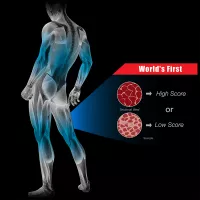When we want to see whether someone is strong, we often look at the size of their muscles. Someone who has large, bulging muscles must be able to lift a lot. However, the truth is more nuanced than that. Not only the quantity of muscles is important, but also the muscle quality. Two people whose muscles are equally big may therefore have different levels of strength. Even within one person there can be differences. The left leg can for example be stronger than the right one. It is important to be aware of this, as that can lead to injury.
Why does muscle quality differ? Your muscles consist of two major types of tissue. First there is contractile tissue. As the name suggests, this contracts and produces force. The other type is non-contractile tissue. This consists of connective tissue and fat. Connective tissue keeps the muscle together, and fat provides energy. The more contractile tissue a muscle consists of, the stronger it is and the higher the muscle quality is. As said, you need some non-contractile tissue. However, if fat levels are especially high the muscle will be less strong and the muscle quality will be lower.
These differences in muscle quality are not only a factor between individuals, there can even be differences within one person. For example, in a runner, the left leg’s muscle might be stronger than the right. The left leg then produces more strength than the right one. That can have a negative impact on the stance of the hips and even lead to injury.
We know that more contractile tissue means better muscle quality. That means there are two things we can do to improve ours: making our contractile tissue stronger or decreasing the amount of non-contractile tissue. Luckily, strength training helps with both of these things. So, even if you’re an avid runner, it might be a good idea to pick up some weights from time to time.
How do you measure muscle quality? To keep your body balanced and check if you are doing well, it’s smart to keep tabs on your muscle quality. In the past, this wasn’t possible without visiting a doctor. However, technology has progressed and you can now measure your muscle quality at home with several of Tanita’s new Dual Frequency analyzers. The RD-901plus, RD-952, and RD-545IM will provide a muscle quality score on a scale of 1 to 100, higher values indicate better muscle conditioning. And of course they will also measures everything our other Body Composition Monitors do.



Comments